On May 16, 2025, the Institute of Construction and Urban Economics (ICUE), in collaboration with the People’s Committee of Hoi An City, organised the inauguration and handover ceremony of the Green Space and Coastal Park (officially named Âu Cơ Park). This is the result of the project “Preventing erosion on Cua Dai beach through green corridors and park”, funded through the IKI Small Grant Programme and aimed at enhancing capacity and climate action and protecting biodiversity at both national and local levels.
Climate change increasingly has severe impacts on the livelihoods of millions of coastal residents and marine ecosystems. Viet Nam, with over 3,200km of coastline, has 28 out of 63 provinces and cities bordering the sea and thousands of coastal fishing communities. Among them, Quang Nam Province, especially Hoi An Ancient Town — a UNESCO World Cultural Heritage Site — has been seriously affected by the coastal erosion along Cua Dai beach.
According to the 2022 Report, from 2016 to 2022, the Cua Dai coastal area lost approximately 112 hectares of land due to erosion, and nearly 70% of the protective coastal forest was damaged, mainly due to rising sea levels.
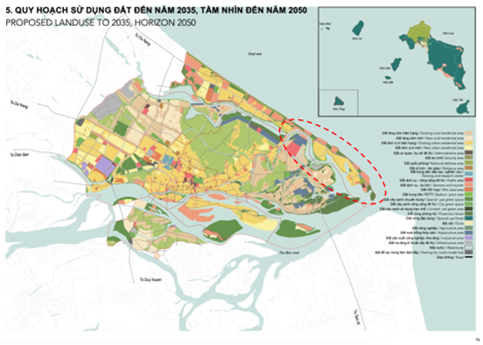
to 2035 – Vision to 2050
To address the local coastal degradation, ICUE has implemented the IKI Small Grant project with strong collaboration from local authorities, socio-political organisations of Cua Dai Ward and the local community.
Strengthening the Coastal Corridor in Hoi An
The project established a coastal green corridor with native species such as Casuarina (Casuarina equisetifolia), Barringtonia asiatica, beach morning glory, and mangrove apple trees to block wind, reduce erosion, and raise public awareness of climate change.
A multi-layered planting solution was applied, combining shrubs and ground cover plants to create a sustainable ecosystem, enhance adaptability and protect the coastal environment.
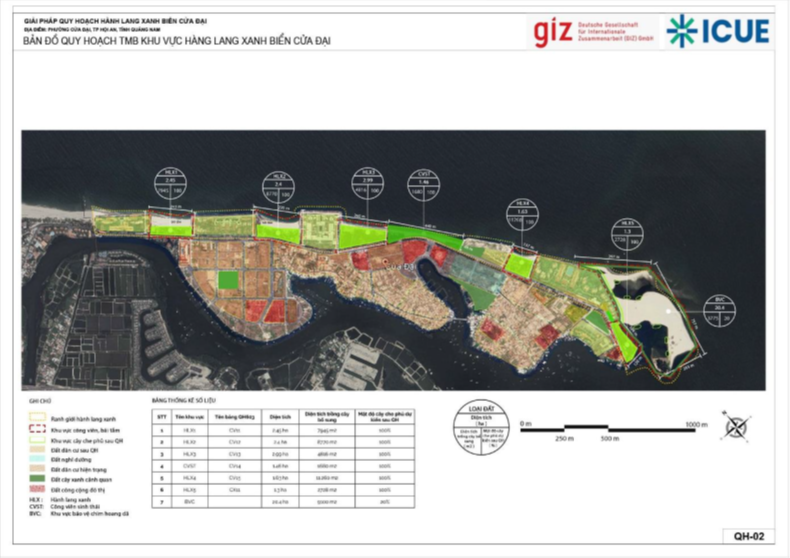
The principle of natural regeneration was applied, supplemented with additional planting and protection of native habitats to minimise human and animal intrusion into wildlife habitats.
Enhancing the Community Park
A community park has been constructed along the coastline with a total area of approximately 10,000m², located between Green Corridor No. 3 and the tourism business zone. The park aims to create a green space for the community, raise awareness of ecosystem protection and promote biodiversity conservation.
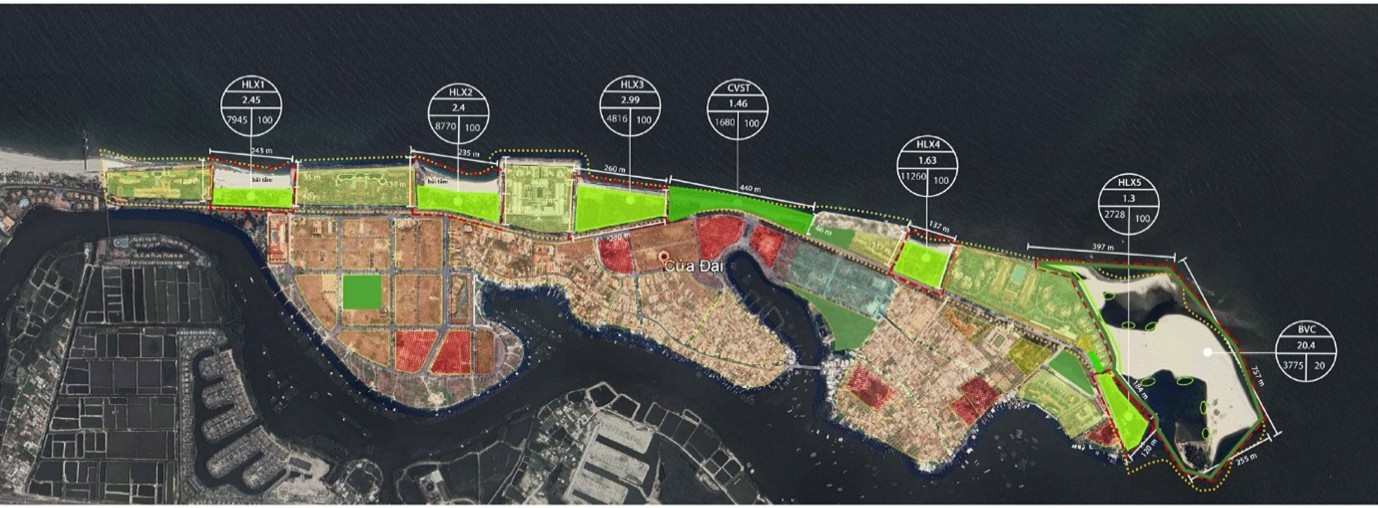
The park consists of a public utility area, including cycling paths, seating areas, recycling stations and information boards, public restrooms, a seating area featuring shaded seating, picnic tables and solar-powered lighting, a sports area designed for all age groups with facilities such as table tennis, shuttlecock kicking, badminton, and sensory playgrounds and including accessible ramps for people with disabilities, a children’s playground inspired by the Sumatra Tern bird. The playground offers diverse physical activities such as climbing, hiding and sliding and fosters children’s connection with nature.
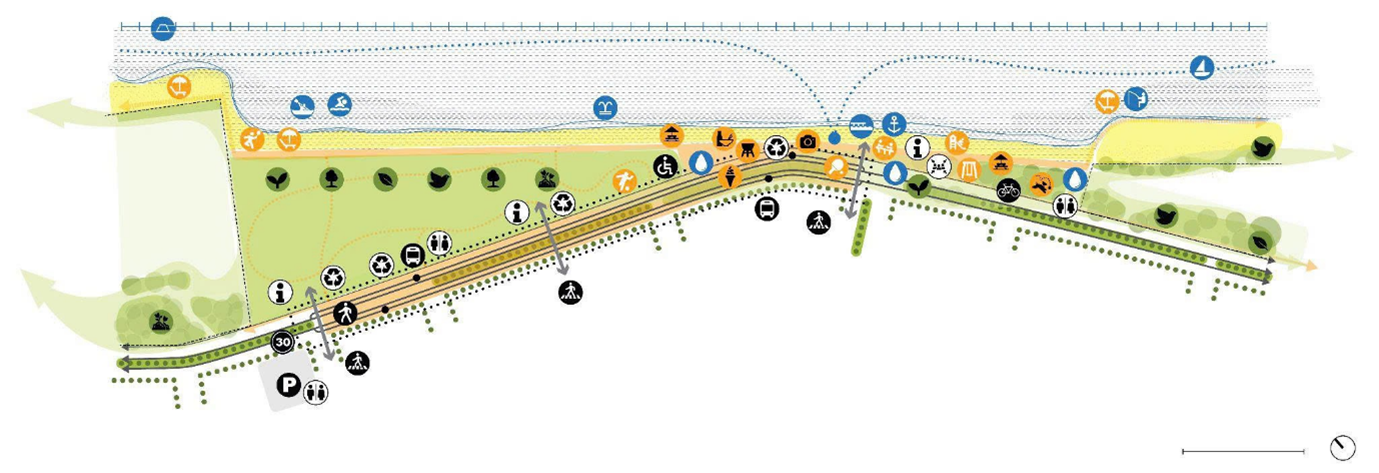
Protecting Wild Bird Conservation Area
Within the project area, a wetland depression has been recorded, hosting up to 103 bird species, including 11 species listed in the Viet Nam Red Data Book and the IUCN Red List, such as the Bar-tailed Godwit, Great Knot, and others.
The project implemented suitable vegetation planting to protect this area and recommended that local authorities strictly enforce wildlife protection regulations.
Additionally, eco-tourism such as bird-watching and wildlife observation were proposed to promote green tourism linked to conservation.
Naming the Community Park
The park was named Âu Cơ, honoring the legendary Mother of the Vietnamese people, expressing national pride, cultural roots, and the desire to build a sustainable green space for the community.

The inauguration marks not an end, but a new beginning for future collaborations, aiming towards greener and more sustainable cities in Viet Nam and beyond, contributing to the protection of coastlines against global climate change challenges.
For more details, please refer to the full content at: Preventing Erosion on Cua Dai Beach through the Development of Green Corridors and an Eco-Park in Hoi An, Quang Nam – International Climate Initiative (IKI) in Viet Nam
For more information about the project, please visit: Preventing erosion on Cua Dai beach through green corridors and parks | Internationale Klimaschutzinitiative (IKI)
In the North Central Coast of Viet Nam, coastal forests provide crucial protection from storms, flooding and erosion. Yet, decades of overuse and the region’s harsh environmental conditions with sandy soils, high salinity, low nutrient content and extreme winds have left these forests highly degraded. Since 2018, unique land use GmbH and its partner, the Hue Union of Science and Technology Associations (HUSTA) have been implementing and fine-tuning the “Ecosystem-based adaptation on the northern central coast of Viet Nam: restoration and co-management of degraded dunes” project. The main objective of the project was to demonstrate how to restore degraded coastal forests by planting site-adapted native tree species and upscaling the model.
Being in its final phase, the project has gained many important experiences and lessons learned that are useful for Ecosystem-based Adaptation (EbA) in Viet Nam and beyond. Among the most important ones is that one major success factor of any tree planting initiative lies in the quality of the seedlings, impacting their growth performance and long-term survival. Often, seedling costs are perceived as a mere cost factor and accordingly, the seedling quality is very low. This translates into poor growth performance and high mortality rates, especially on sites with challenging soil and climatic conditions.
Why high-quality seedlings?
Across reforestation projects globally, success has often been measured by numbers: how many seedlings planted, how many hectares covered. However, focusing solely on planting numbers overlooks the critical question: how many seedlings survive post-project and grow well – a prerequisite to perform and contribute to mitigation, enhanced resilience or effective biodiversity protection?
The starting conditions in the North Central Coast were inherently difficult: strong frequent storms and flooding in the rainy season, extreme heat and prolonged droughts in the summer. In such difficult sites, successful establishment and long-term survival depend on species’ capability to cope with these hard conditions. Crucial are strength and morphology of roots, species suitability and early-stage care. Poor-quality seedlings often fail to establish, impacting the long-term goals and ultimately increasing restoration costs (e.g. through replanting).
Establishing a new quality standard for native tree seedlings
Initially, the project collected the seeds and contracted nursery owners to raise the seedlings. While the shoots looked decent as long as they were in the nursery, the roots were underdeveloped. Triggered by low quality and corresponding mortality rates of the first plantings, we have taken a decisive step in 2020 by taking the seedling production in our own hands. For this, the project established a best-practice nursery in partnership with a highly motivated and knowledgeable private nursery owner in Cam Lo in Quang Tri Province. Designed exclusively for native tree species, the nursery provides an environment where resilient seedlings can develop robust root systems adapted to extreme climate conditions.
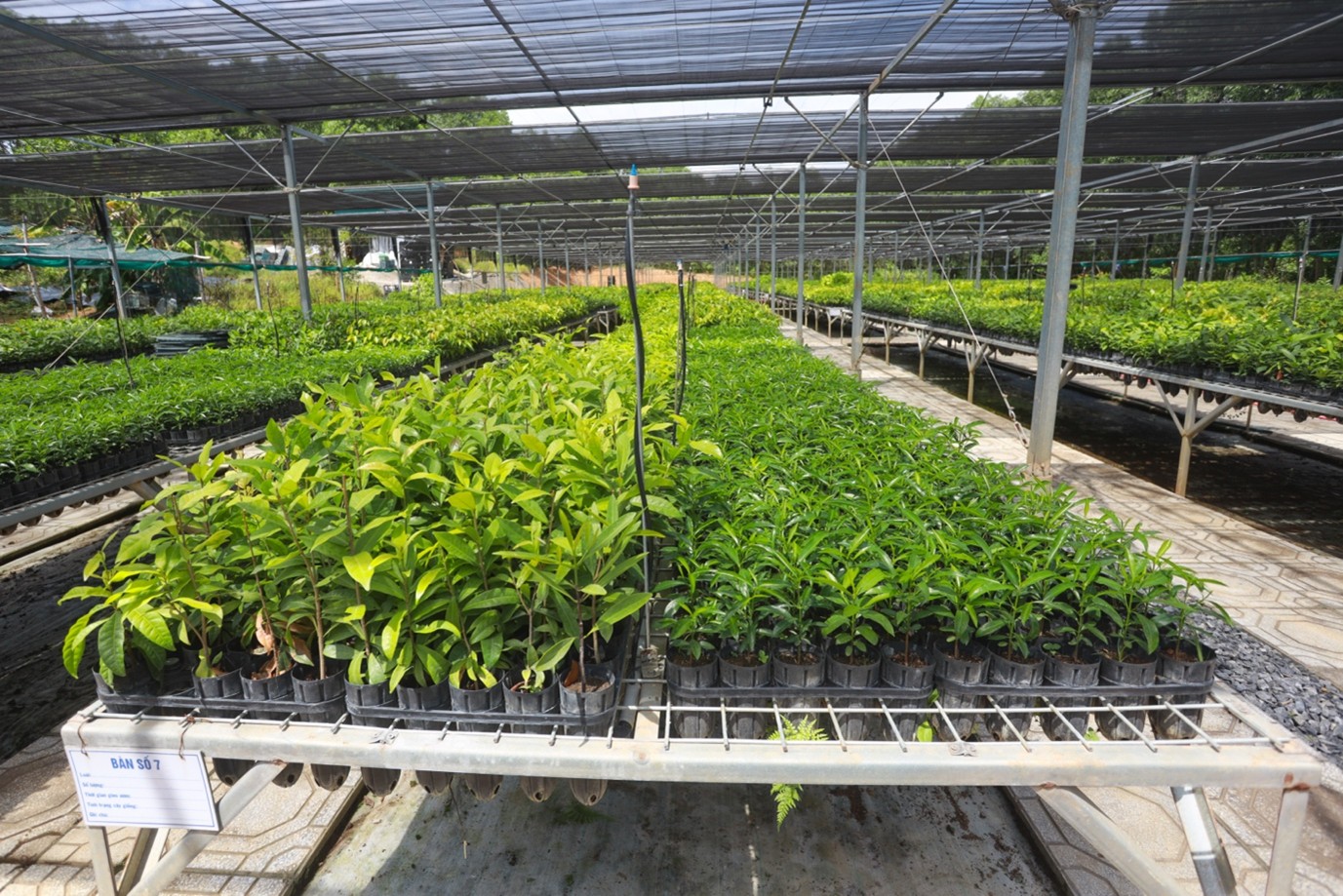
Examples for the high-quality-seedling approach
Common forestry nurseries in Viet Nam typically use simple ground-level seedbeds or small polybags placed directly on the ground. Neither specific substrate is used, nor provide the containers enough space for the tap root. These practices often lead to root spiralling or root breakage during transplanting. The substrate, once planted and exposed to drought, turns into a brick. The Cam Lo nursery builds on international nursery standards and uses raised tables, specific pots and trays, carefully managed and mixed substrates and step-by-step protocols to build seedling health from the start.
Seedlings are produced using cleaned, pre-treated seeds to prevent fungal infections. Germination occurs under shade nets, followed by transplanting into species-specific containers with customised substrates. Modern reusable pots with air-pruning features help prevent root spiralling and promote healthy root development. Root pruning and gradual hardening further strengthen seedlings which are selected for planting based on height and key root traits such as root length, collar diameter and root-to-shoot ratio.
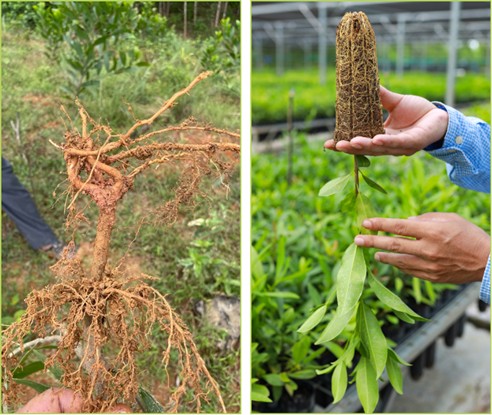
The project team develops and follows detailed protocols outlined in the nursery manual to guide each stage. Techniques include the use of bio-products for disease resistance, pruning guidelines, collection monitoring and pest control practices. Furthermore, the nursery also serves as a training hub to share best-practice methods with other partners and local communities.
Looking ahead
Building on the promising results from the planted “best-practice” seedlings, the project is now exploring options for upscaling which includes a sustainable business strategy for the Cam Lo nursery. Further measures to ensure that the project success is secured include a seed bank in Cam Lo, mapping vigorous mother trees for high quality seeds, commercialising seedling supply, offering nursery setup consultation and launching technical training programmes. This strategy will secure the project’s long-term impact and our commitment to quality, laying the foundation for larger-scale efforts and bringing the coastal forests back to the richness and resilience they once held.
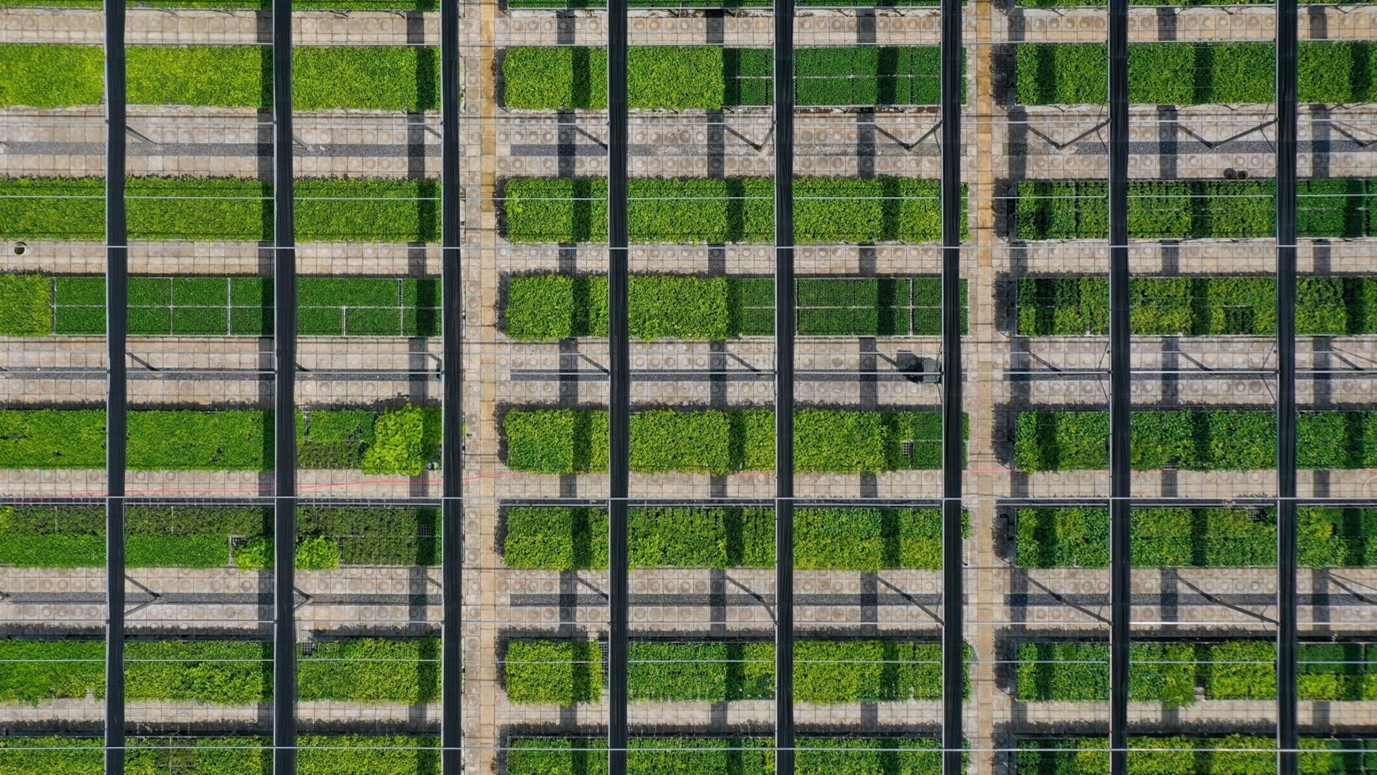
For more information about the project, please visit: Ecosystem-based adaptation on the northern central coast of Vietnam: restoration and co-management of degraded dunes and mangroves | Internationale Klimaschutzinitiative (IKI)
On 29 May 2025, Quang Binh’s Department of Agriculture and Environment (DoAE) in collaboration with the Deutsche Gesellschaft für Internationale Zusammenarbeit (GIZ) GmbH and the Centre for Highland Natural Resource Governance Research (CEGORN) organised a workshop to launch the project “Support to Viet Nam for the Implementation of the Paris Agreement II” (VN-SIPA II) and consult stakeholders on the selection of locations to implement Nature-based Solutions for Adaptation (NbSA) in agriculture in Quang Binh. The workshop gathered a total of 52 attendees from various agencies and organisations, including provincial departments, Women’s Union, Farmer’s Union (at District and Provincial level) and people’s committees and local media outlets.
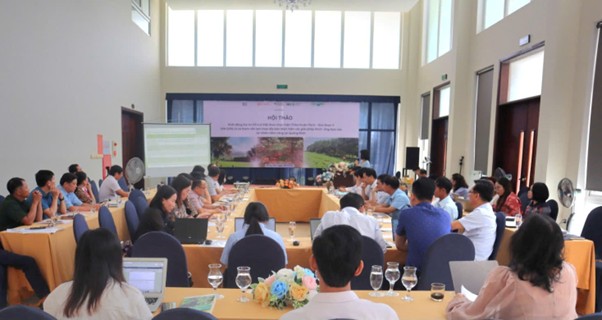
Learning from the results of its first phase, during which GIZ supported the implementation of multiple ecosystem-based climate-smart agriculture measures such as agroforestry, beekeeping, prawn-freshwater aquaculture rotation and the cultivation of Tam onion and drought-tolerant grass, VN-SIPA II continues to strengthen adaptation and biodiversity conservation through NbSA in the agriculture sector.
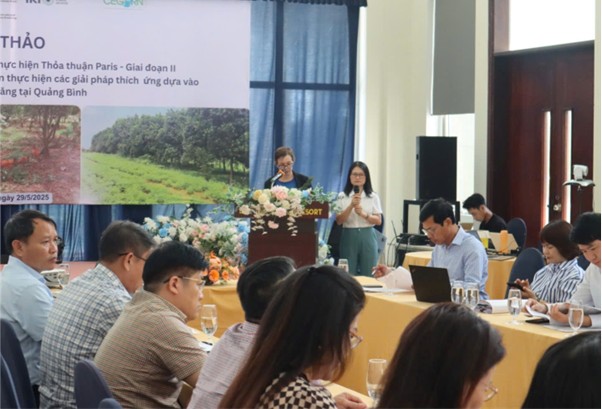
Different stakeholders from Ha Tinh such as the Provincial Agriculture Extension Centre, the Farmers’ Union and a farmer from Ao Tron village shared their lessons learnt from the previous implementation so that stakeholders in Quang Binh could take them into account and learn from them. Furthermore, CEGORN presented the results from their initial survey, consulting different actors from the provincial, district and commune level. The objective was to identify appropriate communes and villages for project implementation, gather supplementary information on natural, economic, and social conditions, including extreme weather events and their impact on people and livelihoods, standardise criteria to select potential NbSA and beneficiaries and determine specific NbSA and beneficiaries for each chosen village.
Based on a number of criteria, from natural features and ecological conditions to agricultural production and business activities and climate change vulnerability, 56 villages were selected from the 12 communes of Tuyen Hoa (Son Hoa, Dong Hoa, Kim Hoa, Huong Hoa, Thach Hoa); Minh Hoa (Xuan Hoa, Trung Hoa, Hoa Hop), and Bo Trach (Hung Trach, Xuan Trach, Cu Nam, Phu Dinh) districts.
Furthermore, criteria to select NbSA were proposed, laying a foundation for future progress. In particular, the NbSA should align with the village’s socio-economic conditions, ecosystem and local characteristics, reduce vulnerability to climate change, enhance ecosystem services and demonstrate reasonable cost, social equity and scalability. In the next stage, village meetings will be held to agree on the selected NbSA, develop criteria for selecting households to implement the NbSA and identify potential households to participate in the project.
The conclusion of the workshop was marked by an active discussion involving local stakeholders. During the discussion, they expressed strong support for the project’s objectives and activities, emphasising the importance of collaboration, experience-sharing and community engagement.
In addition to the field implementation, the project will also support the mainstreaming of NbSA in different planning processes on provincial level. The first provincial plan that will be targeted is Quang Binh’s Climate Change Action Response Plan 2025-2030, with a vision to 2050.
For more information about the project, please visit: Support to Viet Nam for the Implementation of the Paris Agreement II | Internationale Klimaschutzinitiative (IKI)
German Career Truck – a creative and modern interactive space – departed from Hanoi on 26 April, 2025 and is now on a cross-country journey through nearly 20 provinces, bringing Germany closer to Vietnamese youth.
From 25 to 27 May 2025, the Clean, Affordable and Secure Energy for Southeast Asia (CASE) project joined the Career Truck in Ninh Thuan – a province well known for its great potential in wind and solar energy.
The Deutsche Gesellschaft für Internationale Zusammenarbeit (GIZ) GmbH and its partners organised a series of practical activities to raise awareness about green jobs and promote vocational skills training aligned with the needs of renewable energy businesses. Nearly 3,000 students – including many from ethnic minority communities – took part in the event, which featured learning about renewable energy, green jobs, and safe labour migration, exploring German-standard oriented technical professions (such as Mechatronics and Electrical Engineering), and experiencing high-quality training equipment at Ninh Thuan Vocational College (NTVC), experiencing Germany through a virtual reality space and receiving advice on German language and culture from the Goethe-Institute Ho Chi Minh City.
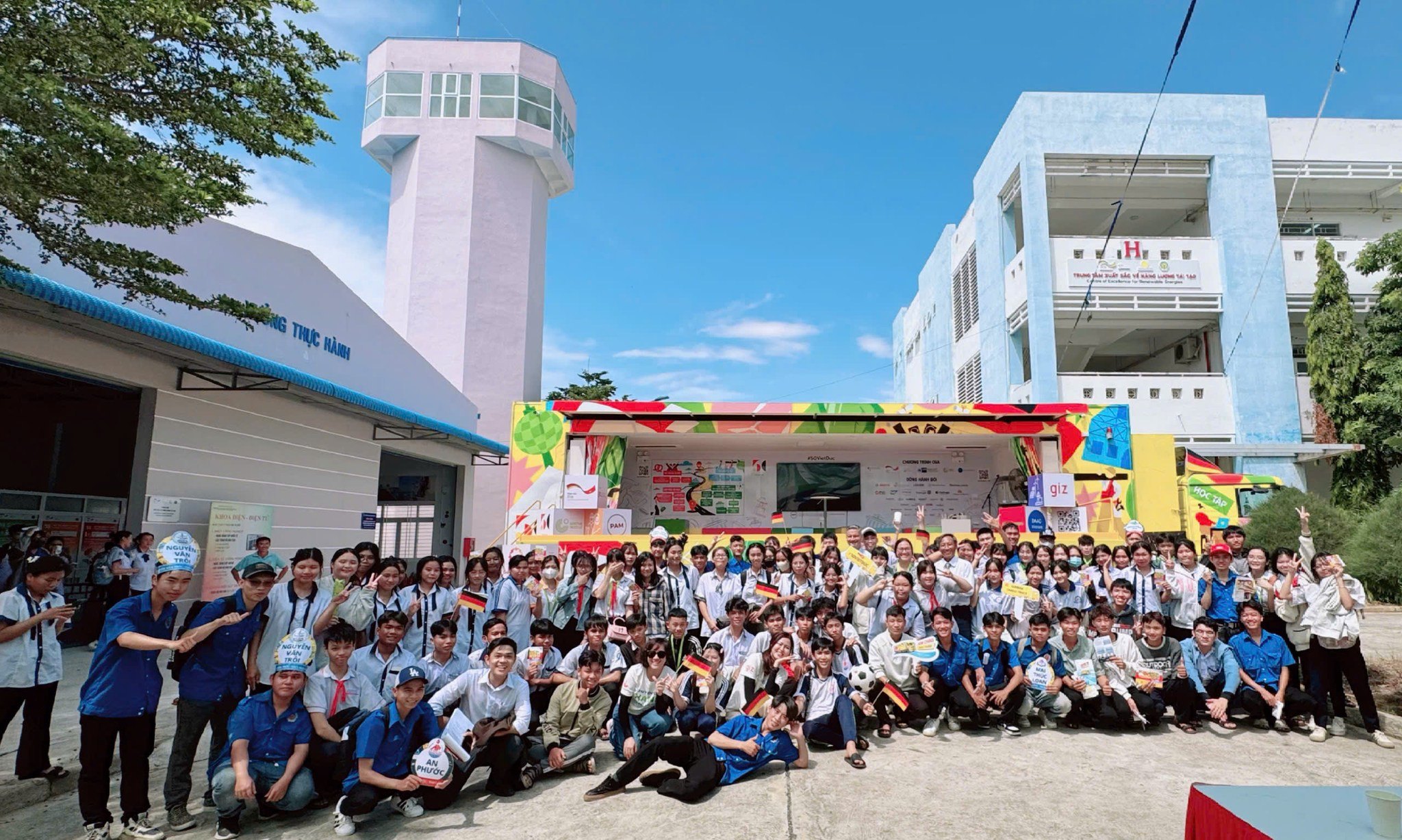
‘The Career Truck gives us a great opportunity to explore German culture, work and life in Germany, and pathways for academic and vocational education as well as labour migration,’ said Ralf Hill, Component Manager for GIZ’s develoPPP Programme – focusing on development cooperation with the private sector in technical vocational education and training (TVET) in Viet Nam.
‘Under the motto ‘Carrying your dreams’, the Career Truck offers access to education and training opportunities both in Germany and Viet Nam, aligned with German standards. It also connects young people with vocational colleges in high-tech sectors such as renewable energy,’ shared Dr. Josefine Wallat, Consul General of Germany in Ho Chi Minh City.

Local leaders also emphasised the significance of the event for both students and broader international cooperation. ‘This is a valuable opportunity for students to gain access to modern career guidance and advanced German vocational training models. It also fosters knowledge exchange and strengthens Viet Nam – Germany cooperation in vocational education,’ said Mr. Tran Trung Dung, Vice Rector of Ninh Thuan Vocational College.
‘The Career Truck carries a profound mission – opening doors to global-standard education and careers for the youth of Ninh Thuan. I believe this programme will inspire our students to step confidently into the world, pursue their dreams, and realise their full potential,’ said Mr. Nguyen Long Bien, a Standing Committee Member of the Provincial Party Committee and Vice Chairman of the People’s Committee of Ninh Thuan.

German Career Truck is part of the celebrations for the 50th anniversary of diplomatic relations between Viet Nam and Germany (1975–2025), helping to connect young people with future career opportunities, education, and international integration. This activity marked a cross-cluster collaboration between the Technical and Vocational Education and Training (TVET), Labour Market and Labour Mobility cluster and the Energy Support Programme under GIZ Viet Nam. The initiative promotes a future-ready Vietnamese workforce by linking the green energy transition with skills development.
For more information about the project, please visit: Clean, Affordable and Secure Energy for Southeast Asia (CASE) | Internationale Klimaschutzinitiative (IKI)
Cuc Phuong National Park, Viet Nam – 22 May 2025
More than 100 government officials, international partners, conservationists and local community members gathered at Cuc Phuong National Park to celebrate the International Day for Biological Diversity 2025. The event, themed Living in Harmony with Nature and Sustainable Development, was organised by the Ministry of Agriculture and Environment (MAE) in collaboration with the People’s Committee of Ninh Binh Province, the United Nations Development Programme (UNDP), and the Support to Viet Nam for the Implementation of the Paris Agreement II (VN-SIPA II) project, commissioned by the German Federal Ministry for Economic Affairs and Climate Action (BMWK) through the International Climate Initiative (IKI).
Hosted at Viet Nam’s oldest national park, the celebration aimed to raise public awareness and rally stakeholder commitment to accelerate the implementation of the Kunming-Montreal Global Biodiversity Framework (GBF) and the National Biodiversity Strategy to 2030, Vision to 2050 (NBS).
Senior representatives, including Vice Minister Nguyen Quoc Tri (MAE), Vice Chairman Nguyen Cao Son (Ninh Binh Provincial People’s Committee) and UNDP Deputy Resident Representative Patrick Haverman, delivered keynote speeches, calling for a unified, whole-of-society approach to biodiversity conservation, particularly in the face of intensifying environmental pressures.

Following the opening ceremony, a technical workshop entitled “Promoting Nature Conservation and Biodiversity for Sustainable Development” was held. The session was chaired by Mr. Nguyen Van Tai, Director General of the Nature and Biodiversity Conservation Agency (NBCA), alongside Deputy Directors Ms. Hoang Thi Thanh Nhan and Mr. Le Van Huu. It provided updates on progress under the GBF and NBS and facilitated knowledge sharing among experts and participants.
During the workshop, NBCA presented the key outcomes of COP16, including: (i) the finalisation of the monitoring framework, (ii) the Planning, Monitoring, Reporting and Review (PMRR) mechanism, resource mobilisation and financial mechanisms, (iii) the Digital Sequence Information (DSI) system and (iv) the Cali Fund, enhanced engagement of Indigenous Peoples and Local Communities (IPLCs), and mainstreaming biodiversity across sectors. The presentation also reviewed Viet Nam’s recent achievements in biodiversity policy development, as well as the establishment, expansion and strengthening of protected areas. Looking forward, NBCA outlined strategic conservation directions, including:
- Expanding and enhancing the management of special-use forests, marine protected areas and biodiversity corridors, guided by the national biodiversity master plan
- Strengthening areas of national and international ecological significance
- Institutionalising and scaling up Other Effective area-based Conservation Measures (OECMs)
- Restoring degraded ecosystems and conserving endangered and migratory species, particularly those classified as rare or precious
- Conserving genetic resources and ensuring fair and equitable benefit-sharing, while protecting traditional knowledge
- Updating national endangered, precious and rare species lists, improving rescue and conservation facilities and reinforcing the national rescue centre network
- Valuing biodiversity’s role in sustainable development, climate adaptation and disaster risk reduction
- Controlling harmful human activities that adversely affect biodiversity

In a joint presentation, GIZ, UNDP, WWF and IUCN outlined their support to Viet Nam in achieving the GBF goals. This includes technical cooperation to re-align national biodiversity targets with GBF priorities, adjust national indicators and monitoring frameworks and prepare the 7th and 8th National Reports. Development partners also highlighted initiatives to institutionalise OECMs and strengthen resource mobilisation for biodiversity financing.
Case studies from Cuc Phương and Tram Chim National Parks provided first-hand perspectives on the challenges and successes of biodiversity management in Viet Nam. Despite ongoing limitations in funding, staffing and equipment, both parks continue to demonstrate a strong commitment to conservation, with speakers emphasising the need to resolve policy overlaps, build technical capacity and embed local and scientific knowledge into national planning.
In his closing statement, Director General Nguyen Van Tai stressed that public expectations for biodiversity action are at an all-time high. “What we need now is a holistic approach that engages all sectors of society,” he stated. “This includes improving policy coherence, integrating field data into decision-making, and developing a comprehensive, real-time national biodiversity database to underpin every aspect of biodiversity governance.”
For more information about the project, please visit: Support to Viet Nam for the Implementation of the Paris Agreement II | Internationale Klimaschutzinitiative (IKI)
The IKI project “Cultivation of Energy Crops on Post-Mining Sites (CPEP)” has demonstrated that the cultivation of energy crops on post-mining sites is feasible despite challenging growing conditions. It also offers clear co-benefits such as improved soil quality, which can support the economic or ecological reuse of the land in the medium term. In addition, expert discussions during the project revealed a high level of political will to promote the cultivation of energy crops in Viet Nam, in case there is no trade of with food production. Further interest was expressed in considering other types of marginal land along with mining land. However, to date, comprehensive data on these marginal lands in Viet Nam is not available for designing reliable land use planning. Therefore, as part of a follow-up activity for the CPEP project, the idea was to develop an inventory scheme to characterise, quantify and map marginal lands in selected provinces, using existing in combination with survey and monitoring activities. As such, the marginal areas that can be used for energy crop cultivation were mapped, evaluated and assessed for potential availability in the catchment area of two bioethanol plants operated by Tung Lam in the provinces of Dong Nai and Da Nang, located in Southern and Central Viet Nam.
For the methodological approach, areas identified as marginal were digitised as polygons in a GIS using recent aerial photographs. In addition, geospatial information relevant to the project – such as geology, soil types, vegetation and administrative boundaries – was georeferenced and integrated into the GIS. In this way, further information could be added to each area analysed. Only areas larger than 5 ha, considered to be the minimum size for economically viable energy crop cultivation, were included. In addition, exclusion areas have been defined, such as contiguous forest areas, protected areas, settlement areas and areas used for agriculture, as these areas are generally unsuitable for energy crop cultivation.
Among 1,016 marginal areas were mapped in the provinces of Dong Nai, Ba Ria-Vung Tau and Binh Thuan, not all were considered suitable for energy crop production. The main reasons for this classification are the presence of sandy and/or rocky soils and steep slopes in these areas (Figure 1). In total, about 2.5% of the combined area of the three aforementioned provinces in the southern study area can be considered marginal. In the provinces of Da Nang and Quang Nam, 164 marginal areas were identified, however, similar to the findings in the South – only a small proportion is suitable for energy crop cultivation. Analysis shows that sandy soil is the most common reason of soil degradation in Da Nang, accounting for 46% (Figure 1).

Due to the expected data limitations of remote sensing alone, in a second iteration the aerial survey sites were partially verified by visiting selected sites based on a stratified random sampling design. On the one hand, the selection of the visited sites was based on the types of cases identified (sandy soils, erosion, etc.). On the other hand, an appropriate level of accessibility was required for the practical implementation of the inspections. One example from these ground checks is presented in the Figure 2. The area with the code number 1131 is suitable for the cultivation of energy crops; cassava is already planted in the surrounding area. The reason for not planting is a somewhat rocky and uneven subsoil. However, due to rocky and uneven subsoil, energy crops haven’t been planted.

In summary, a total of 1,180 marginal areas were identified by remote sensing for both study areas in Viet Nam, including 107 mining sites. However, only 72% of the land in the South and 44% in the North were found to be suitable for energy crop cultivation. Common reasons for considering these sites unsuitable included signs of enar-time re-use, clearly visible erosion damage and the risk of flooding. In the end, 800 sites remained that could be considered potentially suitable for energy crops (Table 1). Some of these areas were verified by field inspections to check the plausibility of the aerial image analysis. These inspections revealed that some of the mapped marginal areas were already in use or about to be used, especially in areas with infrastructure and fewer site restrictions. As a result, the total number of potentially suitable areas must therefore be revised downwards due to the uncertainties associated with the aerial image analysis.
Table 1: Summary of number and size of remotely sensed marginal sites in the two study areas in Viet Nam.
| Number of Sites | Saher (%) | Size (ha) | |
| Suitable sites | 800 | 68% | 22,185 |
| Unsuitable sites | 380 | 32% | 13,682 |
| Sum | 1,180 | 100% | 35,867 |
It should be noted that in most of these sensed areas, energy crops can only be grown if massive measures are taken to compensate for the limiting factors. These measures include high costs for irrigation, fertiliser and substrate. It is questionable whether these measures would pay off in an already tight renewable energy market. However, the mapped areas could be ideal locations for photovoltaic or wind power generation and should be explored in this respect – in this way the results could still help to promote the expansion of renewable energy without competing with food production. At the same time, Viet Nam’s Prime Minister approved a new plan for mineral extraction (866/QD-TTg, Approval for Planning for Exploration, Extraction, Processing and Use of Minerals for the Period of 2021-2030 with a Vision to 2050), which will significantly increase the area required for mining after 2030. In the near future, therefore, Viet Nam is expected to see a significant increase in post-mining land, which will dramatically increase the amount of marginal land. As a result of these exploitation plans, there will be a future need to develop land use planning strategies for these sites. The approach presented in this article is a sound demonstration of how these sites can be systematically categorised in a GIS as a first step to develop land use planning strategies – a response to the ever-increasing land use pressures in Viet Nam.
To learn more about the first phase of the energy crop cultivation project on former mining sites, please visit: Cultivation of Energy Crops on former Mining Sites on a Pilot Scale in Viet Nam
Contact: Ute Mark & Dr. Harald Mark, mark@msp-bochum.de; Dr. Arne Reck, arne.reck@ufu.de;
IKI Project News
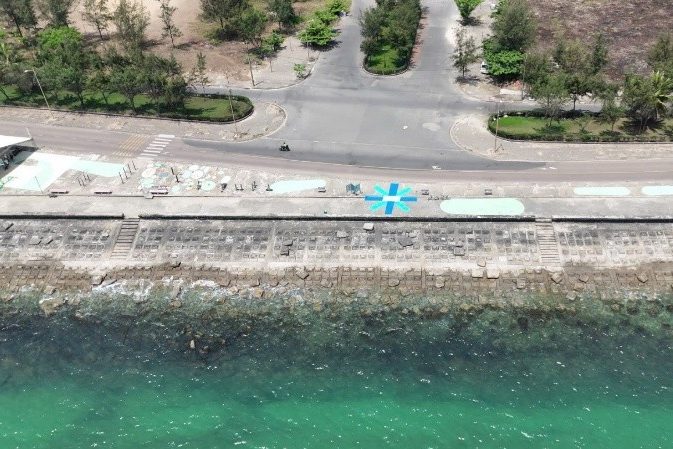
On May 16, 2025, the Institute of Construction and Urban Economics (ICUE), in collaboration with the People’s Committee of Hoi […]
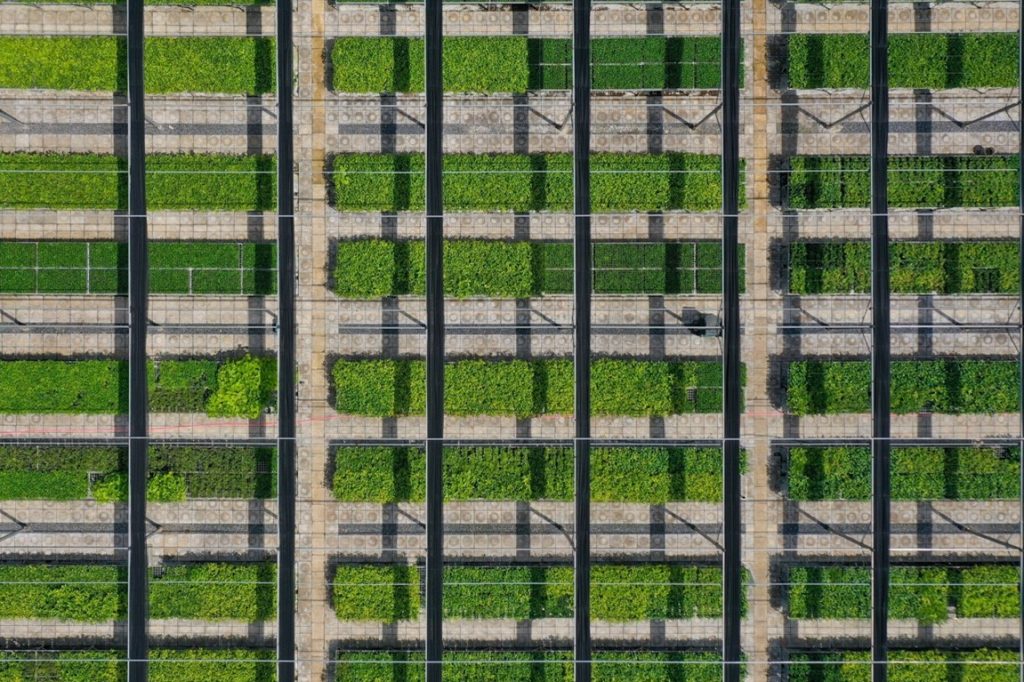
In the North Central Coast of Viet Nam, coastal forests provide crucial protection from storms, flooding and erosion. Yet, decades […]
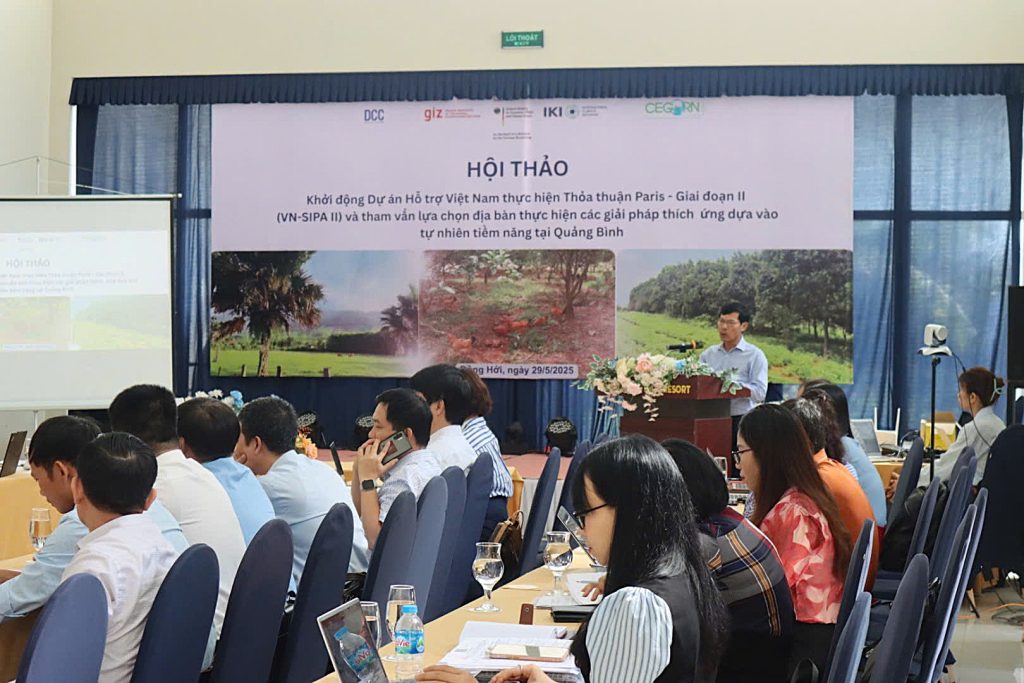
On 29 May 2025, Quang Binh’s Department of Agriculture and Environment (DoAE) in collaboration with the Deutsche Gesellschaft für Internationale […]

German Career Truck – a creative and modern interactive space – departed from Hanoi on 26 April, 2025 and is […]
IKI-Newsletter
Keep up with our latest news and events. Subscribe to our newsletter.
Climate and Biodiversity News
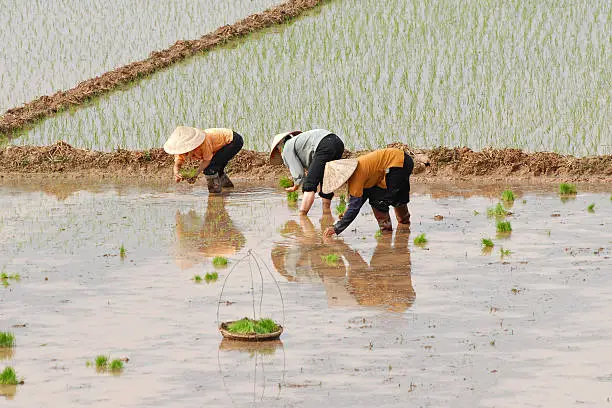
On 16 June 2025, the Vietnamese government issued Decree No. 156/2025/ND-CP, a significant update to the national credit policies for […]
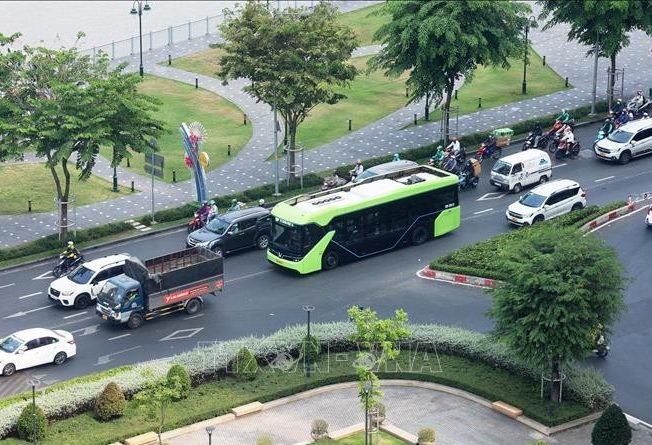
Ho Chi Minh City, 31 July, 2025 — The Ho Chi Minh City Department of Construction, in collaboration with Phuong […]
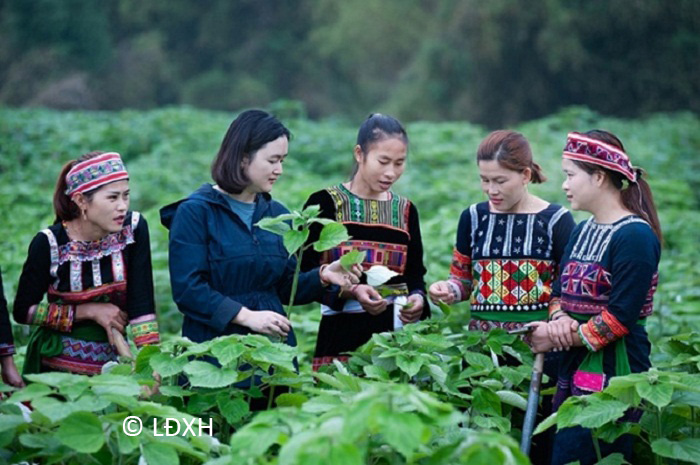
The annual session of the Executive Board of the United Nations Entity for Gender Equality and the Empowerment of Women […]
Events
We would like to inform you that the 2025 IKI Interface Viet Nam Workshop is scheduled to take place on […]
The IKI Interface Viet Nam team invites you to the IKI Implementer Meeting on Gender Mainstreaming: Sharing Good Practices from […]
We invite you to an IKI Implementer Meeting on the Global Biodiversity Framework (GBF) Monitoring in Mechanism and Indicators. […]
GIZ Country Office, 6th Floor, Hanoi Tower, 49 Hai Ba Trung Street, Hanoi, Viet Nam
We invite you to an IKI Implementer Meeting on Viet Nam’s Emission Trading Scheme (ETS). Date and time: Tuesday, […]
GIZ Country Office, 6th Floor, Hanoi Towers, 49 Hai Ba Trung Street, Hanoi, Viet Nam
We invite you to an IKI Implementer Meeting on Viet Nam’s Updated National Adaptation Plan (NAP) Date and time: Thursday, […]
Recent Publications
Viet Nam’s electricity sector set to expand to 500,000 full-time jobs by 2035, up from around 300,000 today. This surge reflects the transformative scale of the country’s energy transition according to Decision 500/QD-TTg 2023 on National Power Development Plan Nr 8 dated 15 May 2023.
👉 Where will these new jobs come from? What does this mean for existing workers?
GIZ ESP’s new report “Projection of Labour Force for Viet Nam’s Energy Transition” explores potential development of the labour force in the power sector in Viet Nam and related industries under different scenarios stated in PDP8 and JETP:
✅ Solar and wind will lead job growth
PDP8 set an ambitious capacity for solar and wind power, with specific targets of 12,836 MW and 27,880 MW for solar and wind capacity by the 2030s, respectively. As a result, over half of the power sector’s direct workforce is expected to be employed in solar and wind technologies. This requires investment in skills and training.
⚠️ Workforce transition from coal to more sustainable sectors
As the coal industry for power gradually scales down, the labour demand will decline. However, the rapid growth of the renewable energy sector and other green economy is creating new job opportunities. With timely policies and reskilling programs, coal workers can successfully transition to sustainable livelihoods, supporting social stability and regional development.
🌏 Imports now, localisation later
While Viet Nam currently relies on imported components, improving human capacity will enable greater participation in the renewable energy supply chain. In the long term, localisation will be key to building a resilient and self-sustaining industry.
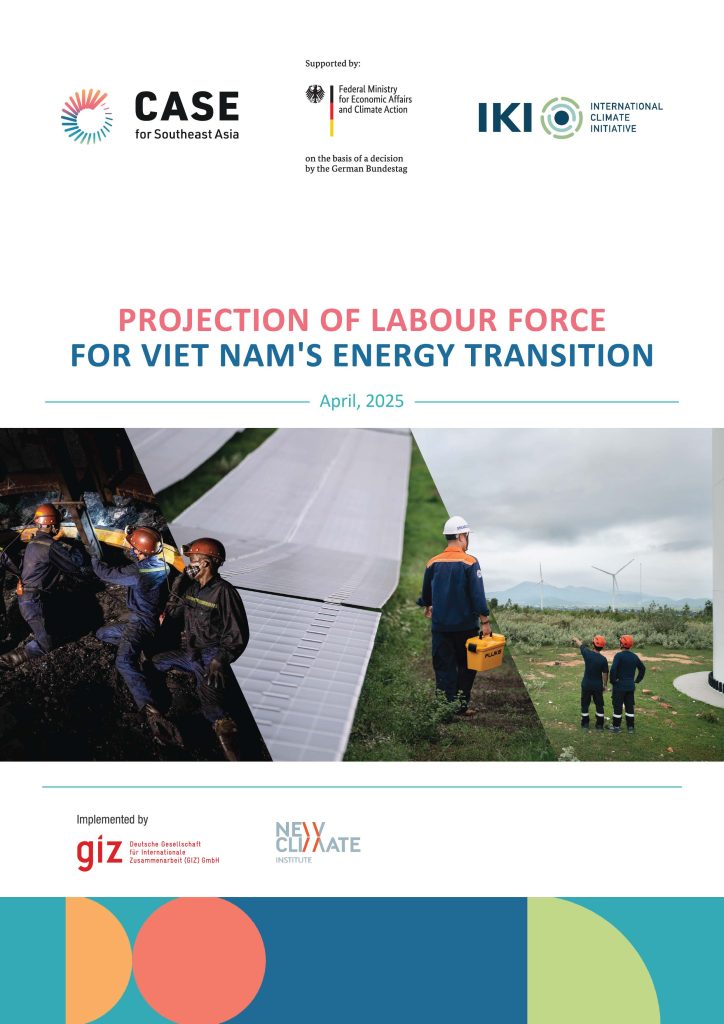
Words shape the world—and our climate story. 🌏
📝 Climate and Energy Terminology Handbook for Media and Journalists is now available in Vietnamese!
Whether you’re a policymaker, energy expert, journalist, or student, precise language is crucial to drive real action.
➡️ Download the handbook and speak the language of energy transformation
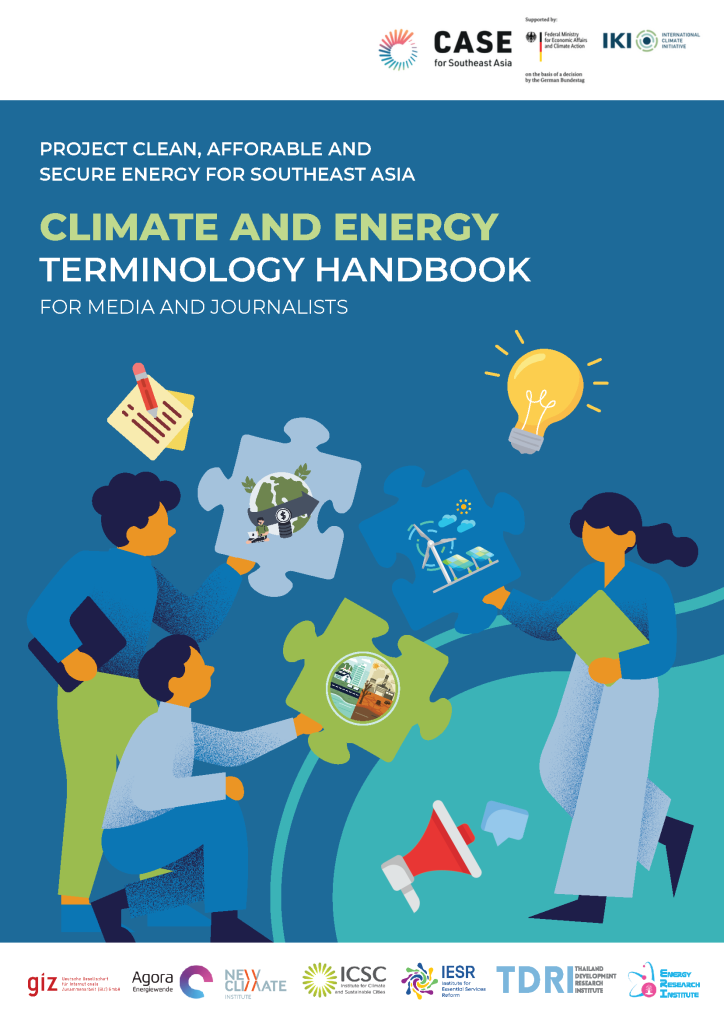
The Green Cooling Initiative III (GCI III), spearheaded by the German Federal Ministry of Environment, Nature Conservation, Nuclear Safety and Consumer Protection (BMUV), is a comprehensive and ambitious global endeavor designed to advance sustainable cooling practices worldwide. This initiative targets key countries, including Viet Nam, with the goal of promoting the adoption of energy-efficient cooling technologies that use natural refrigerants. Deutsche Gesellschaft für Internationale Zusammenarbeit (GIZ) plays a pivotal role as the primary implementing agency for this project.
Through these collaborative efforts, GCI III aims to bolster the ability of stakeholders to adopt and implement green cooling solutions effectively. This, in turn, contributes significantly to advancing Viet Nam’s sustainability agenda and achieving its climate targets, positioning the country as a leader in the global movement towards environmentally friendly cooling technologies.
This assignment centers on elaborating a market study and developing a transformation plan for green cooling technologies in the domestic and retail refrigeration subsectors under the food cold chain sector in Viet Nam.

Viet Nam is a rapidly developing nation facing both population growth and the impact of climate change with over 99 million people and a high population density, Viet Nam’s economic expansion and urbanization contribute to an escalating demand for cooling. It plays a major role in economic and social development including the food processing, freezing, electronics and pharmaceutical industries. However, this growth also intensifies the environmental strain, since the cooling sector is one of the largest sources of greenhouse gas (GHG) emissions. In 2016, it constituted 9% of the country’s total emissions, emitting 28.7 Mt CO₂eq (GIZ, 2019).
Addressing this issue becomes the objective of the project, aiming to conduct a comprehensive market survey and develop a transition plan that prioritises green cooling technologies, particularly within the domestic and commercial refrigeration subsectors. The project focuses on the cold food supply chain and aligns with the dual objectives of economic growth and environmental sustainability. Through strategic adoption of green cooling technologies and low GWP refrigerants, this initiative not only aims to revolutionise cooling practices but also seeks to foster a sustainable, resilient, and environmentally conscious trajectory for Viet Nam’s development.



